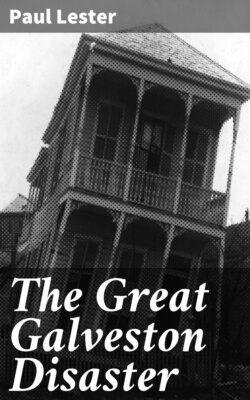Читать книгу The Great Galveston Disaster - Paul Lester - Страница 3
На сайте Литреса книга снята с продажи.
CHAPTER I.
First News of the Great Calamity—Galveston Almost Totally Destroyed by Winds and Waves. Thousands Swept to Instant Death.
ОглавлениеTable of Contents
The first news of the appalling calamity that fell like a thunderbolt on Galveston came in the following despatch from the Governor of Texas:
“Information has just reached me that about 3000 lives have been lost in Galveston, with enormous destruction of property. No information from other points.
“JOSEPH D. SAYRES, Governor.”
This despatch was dated at Austin, Texas, September 9th. Further intelligence was awaited with great anxiety in all parts of the country. The worst was feared, and all the fears were more than realized. Later intelligence showed that the West Indian storm which reached the Gulf coast on the morning of September 8th, wrought awful havoc in Texas. Reports were conflicting, but it was known that an appalling disaster had befallen the city of Galveston, where, it was reported, a thousand or more lives had been blotted out and a tremendous property damage incurred. Meagre reports from Sabine Pass and Port Arthur also indicated a heavy loss of life.
Among those who brought tidings from the stricken city of Galveston was James C. Timmins, who resides in Houston, and who is the General Superintendent of the National Compress Company. After Mr. Spillane he was one of the first to reach Houston with news of the great disaster which had befallen that city, and after all he reported it was evident that the magnitude of the disaster remained to be told.
After remaining through the hurricane on Saturday, the 8th, he departed from Galveston on a schooner and came across the bay to Morgan’s Point, where he caught a train for Houston. The hurricane, Mr. Timmins said, was the worst ever known.
The estimate made by citizens of Galveston was that four thousand houses, most of them residences, were destroyed, and that at least one thousand people had been drowned, killed or were missing. Business houses were also destroyed. These estimates, it was learned afterward, were far below the actual facts.
The city, Mr. Timmins averred, was a complete wreck, so far as he could see from the water front and from the Tremont Hotel. Water was blown over the island by the hurricane, the wind blowing at the rate of eighty miles an hour straight from the Gulf and forcing the sea water before it in big waves. The gale was a steady one, the heart of it striking the city about 5 o’clock in the evening and continuing without intermission until midnight, when it abated somewhat, although it continued to blow all night.
